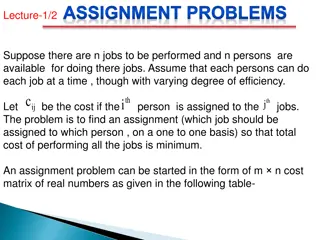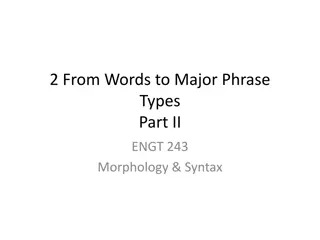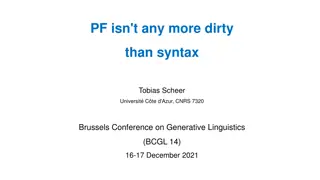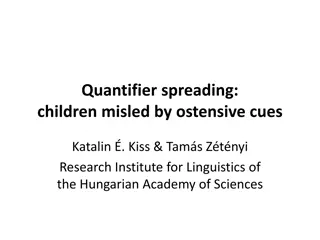Linguistic Evolution of Hungarian: From Ugric to Modern Syntax
The origin of the Hungarian language is debated, with doubts arising due to limited evidence of Uralic roots. Variations in syntax between Ugric and Hungarian are analyzed, suggesting a shift over time. Early Old Hungarian texts display remnants of Ugric structures, providing insights into the language's evolution.
Download Presentation

Please find below an Image/Link to download the presentation.
The content on the website is provided AS IS for your information and personal use only. It may not be sold, licensed, or shared on other websites without obtaining consent from the author.If you encounter any issues during the download, it is possible that the publisher has removed the file from their server.
You are allowed to download the files provided on this website for personal or commercial use, subject to the condition that they are used lawfully. All files are the property of their respective owners.
The content on the website is provided AS IS for your information and personal use only. It may not be sold, licensed, or shared on other websites without obtaining consent from the author.
E N D
Presentation Transcript
Old Hungarian: Halfway between Ugric and Modern Hungarian Katalin . Kiss CIFU XII, August 19, 2015
Why is the Uralic origin of Hungarian doubted by many? Because the main evidence is allegedly only a handful of regular sound correspondences and reconstructed words. Syntax: fundamental differences
Differences: Ugric: Hungarian: SOV fixed word order fused thematic and discourse roles non-finite subordination clause-final complementizer no articles verbal agreement with topical object differential object marking SVO free word order separate thematic and discourse roles finite subordination clause-initial complementizer articles verbal agreement with definitene object general object marking
Claim: The first Old Hungarian documents (1200-1500 still have remnants of the Ugric syntactic patterns; Hungarian must have lost its Ugric syntactic traits in the late Proto-Hungarian period (500-900) and /or the early Old Hungarian period (900-1200).
Ugric type remnants in early Old Hungarian Khanty: strict SOV, with unmarked object (1) a. (luw) juwan he Ivan He hit Ivan. re:sk- s hit- PAST.3SG b. juwan Ivan Who was Ivan hit by? xoj-na who-LOC re:sk- s-a hit-PAST-PASS.3SG
Old Hungarian non-finites: sporadic unmarked objects strict SOV Adverbial participial clauses (2) [ gondoluan] yme vrnac angala he this thinking lo Lord s angel i lenec appeared n ki him while he was thinking this, lo, the Lord s angel appeared to him. (Munich C. a.1416)
OH: SOV with unmarked object in non-finites Infinitival clauses: (3) ne fordo l lon not turn-SUBJ-3SG back he gown-3SG- put.on-INF he should not turn back to put on his gown m g [ k ntos felu nni ] (Munich C. a.1416) Present participial clauses: (4) Kiral l u li king letters-3SG- writing-PL-ACC those writing the king s letters (Vienna C. a.1416) irokat
OH: SOV with unmarked object in non-finites Perfect participial clauses (5) Agyad meg ymmar [bewne give-IMP back now give it back now to that who has repented his sin zantnak] sin-3SG- repented-DAT (J kai C. a.1370) Predicative participial clauses (6) ky zent fferenczet lewlteuala [egyhaz who St Francis-ACC found who found St Francis sweeping the church feprette] church- sweeping (J kai C. a.1370)
OH: accusative marking VO order: (7) Munich C. (a.1416) Matthew 4,20: Azoc [legottan haloioc they immediately net-3PL- off leaving followed him Leaving their net immediately, they followed him meg hagu ] k uetec tet (8) Jord nszky C. (a.1516): Azok kedyg [legottan they however immediately off leaving es hayoyokat] k weteek hewtet and boat-3PL-ACC followed him el hagywan haloyokat] net-3PL-ACC
The fast decline of unmarked objects: Codexes: tokens unmarked Os token / unm.O J kai C. a1370: 22 733 42 Munich C. a1416: 69 589 78 892 Apor C. a1416: 22 118 18 Vienna C. a1416: 54 423 24 Jord nszky C. a1516: 200 185 16 12 511 token / unm.O 540 1382 2268
Fossilized OV structures with unmarked O in Modern Hungarian: (9) a. szava word-3SG- keeping man a man keeping his word Mi t v legyek? what- doing be-1SG b. esze vesztett ember, mind-3SG- lost man a man having lost his mind c. kalap lev ve hat- off-taking tart ember What shall I be doing? taking off the hat
Ugric and OH non-finite clauses: independent subject, S-V agreement, possessive inflection (10) [na o:l-t-e:n you sleep-PART-2SG to While you were sleeping I went to the forest. (11) Ne zegyenletek [alamyznaert men-tett-ek-et ] (OH) not be.ashamed-2PL alms-for don t be ashamed of asking for alms (Jokai C. 1370) e:lti] ma u:r-na yax-s- -m (Khanty) I forest-LOC walk-PART-1SG go-PART-2PL-ACC
The decline of non-finite subordination: (12) [Nap kedig felk lu ] meg h u l nc sun COORD rising The sun having risen, they burned. PRT burned-PAST-3SG (Munich C. a. 1416) (13) Mykoron az nap fel tamadot wolna, when the sun up rise-PERF-3SG be-PAST meg swte ewket PRT burn-PAST.3SG them When the sun had risen, it burned them. (G bor Pesthi, Novum Testamentum 1536)
Decreasing number of non-finite adverbial clauses Number of -v n/v n clauses in St Matthew: Munich C. a. 1416: 486 Jord nszky C. a. 1516: 322 K roli Bible 1590: 286
Surviving non-finites with possessive inflection in Modern Hungarian Inflected infinitival complements of impersonal predicates: (14) Nem kell/fontos [haza men-n- nk] not needs/important home go-INF-1PL We need not go home/It s not important for us to go home Inflected gerund: (15) [Hazafel men-t-em-ben] tal lkoz-t-am homewards go-PART-1SG-INESS meet-PAST-1SG with-3SG While going home I met him. vele.
Ugric and OH relativization: gap strategy, non-finite prehead relative Khanty: (16) [(m ) tini-m- m] lo I sell-PART-1SG horse the horse which I sold OH: (17) Es ueg ed az [neko d zo rzo -tt-em] Coronat and take the you-DAT obtain-PART-1SG crown-ACC and take the crown which I obtained for you (Kazinczy C. 1526)
OH: decreasing of gap relativization; increasing number of relative pronouns Number of the relative pronouns who, what, which in St. Matthew s Gospel: Munich C. (a. 1416): 225 Jord nszky C. (a. 1516): 314 K roli Bible (1590): 330
Semi-productive gap relativization in Modern Hungarian: (17)a. az [any m s t -tt-e] keny r the mother-1SG baked-PART-3SG bread the bread which my mother baked b. egy [tan r-ok vezet-t-e] vet lked a teacher-s administer-PART-3SG quiz a quiz which teachers administered Only lexical subject, and 3SG agreement.
Ugric and OH: clause-final interrogative particle (18)a. tit ujew- here sleep.1PL-Q Do we sleep here? (Mansi) b. n em wife-1SG there was-Q Was my wife there? (Khanty) t tt .tot-
Ugric and OH: clause-final interrogative particle OH: sporadic clause-final e: (19) Nemd k t v r bec adatnac not two sparrows give-PASS-3PL one-half coin-on Q Are not two sparrows sold for a farthing? (Munich C., Matthew 10,29) Emerging V-adjoined e: (20) Il l es vag t ? Elias are Q you Are you Elias? e -fel penz-en ? Q (Munich C., John 1,21)
Middle/Mod. Hungarian: -e adjoined to the V (or to a preverbal element) Jord nszky C. (a 1516) (21) Nem de ket verebek adatnak ee not two sparrows give-PASS-3PL Q e ffel penzen? one half coin-on (22) yllyes vagy ee the? Elias are Q you
Ugric: no article; definiteness inferred from position, O-V agreement, meaning etc. (23) (Khanty) a. Juwan kala Ivan reindeer kill-PAST.3SG reindeer Ivan-by kill-PAST- PASS.3SG Ivan killed a reindeer. we:l- s b. Kala juwan-na we:l-s-a The reindeer was killed by Ivan (24) a. Ku man boat take-PAST.3SG The man took a boat. rit tu-s b. Ku rit tu-s-t man boat take-PAST-OBJ.3SG The man took the boat.
OH: definiteness derived from meaning, O-V agreement, position, etc. (25) vylag nem vall t oly czudas world not had such wonderful people-ACC the world did not have such wonderful people emberek-eth (26) anyath ezes mother sweet son-3SG-with together and kill the mother together with her sweet son fyaal egembelu ullye-tuk kill-IMP-DEF.2PL (27) qui vleben who lap-3SG-in hold-INDEF.3SG wonderful son-ACC who is holding a wonderful son on her lap tart- chudaltus fio-t
The growing proportion of the definite article in OH between 1370-1526 (Egedi 2015)
Ugric: determination/anchoring by a possessive suffix (Nikolaeva 2002): (22) tam hu:j-e:m xal a joxt- s? (Khanty) this man-1SG where come-PAST.3SG Where did this man come from? (23) n- m I-1SG Kill me! j l- l- l- n. (Eastern Mansi) down-kill-IMP-OBJ.2SG (24) Om n -n I I brought you here on purpose. (Eastern Mansi) jor l t t- s-l m t g. you-2SG on.purpose bring-PAST-OBJ.1SG here
Relics of determination/anchoring by a possessive suffix in OH/Mod.H: (25) eng-em I-1SG t g-ed you-2SG mi-nk-et we-1PL-ACCyoupl-2PL-ACC ti-tek-et (26) a h ly -je, the stupid-3SG the stupid one a zsugori-ja the mean-3SG the mean one
Ugric: differential O-V agreement elicited by topical objects Nikolaeva (1999, 2001, Dalrymple&Nikolaeva 2011): O-V agreement in Khanty iff the O is topic: (27)a. What happened? ma tam kala I this reindeer I killed this reindeer. we:l-s- m kill-PAST-1SG b. What did you do with this reindeer? ma tam kala I this reindeer I killed this reindeer. we:l-s-e:m kill-PAST-OBJ.1SG
OH, MH: differential O-V agreement elicited by definite objects Evidence that it was originally O-V agreement elicited by topical objects: (i) Giv n (1975): Topical O - V agreement is reanalyzed as definite O - V-agreement (e.g., in various Bantu languages)
(ii) In OH, def./indef. conjugation sporadically still determined by the discourse status of O: Topical indefinite O with definite conjugation: (28) Kit Amasias kiral auag pap gakorta getre-tt-e whom Amasias king or priest often whom king or priest Amasias often tortured torture-PAST-DEF.3SG (Vienna C. 1416) Non-topical definite O with indefinite conjugation: (29) Es ottan ve-n and there take-PAST.INDEF3SG divine grace-DAT sight-POSS-ACC and there he took the sight of God s grace (J kai C. 1370) ysteny malaztnak latasatt
(iii) Hungarian has preserved the Inverse Agreement Constraint on topical O V agr. (30) Inverse Agreement Constraint (Comrie 1980) An object cannot elicit verbal agreement if it is higher in the animacy hierarchy than the subject agreeing with the same verb. (31) Animacy hierarchy 1SG > 1PL > 2SG > 2PL > 3SG > 3PL
The Inverse Agreement Constraint constrains the topicalizability of objects Nikolaeva (2001): The primary topic in Ob-Ugric is the subject. A topical object is always a secondary topic. Animacy Hierarchy = Topicality Hierarchy (36) Inverse Agreement = Inverse Topicality Constraint A secondary topic cannot be more topical than the primary topic of the same clause. An object more topical than the subject of the same clause can only be construed as a focus.
Strong IAC in Eastern Khanty, Samoyedic: no agreement with 1st and 2nd person objects (32) Vera w-at Vera she-ACC Vera knows her. w - -t . (Eastern Khanty) know-PRS-OBJ.3SG (33)a. w m n-t /n -at he I-ACC /you-ACC He sees me/you. w - . see-PRS.3SG b. m n -at I I see/know youSG. w - - m. see-PRS-1SG you-ACC (Csepregi p.c.)
Strong IAC also in Tundra Nenets (Dalrymple and Nikolaeva 2011): lad -da. hit- OBJ.3SG (34) Wanya syita John he. ACC John hit him. (35) Wanya syiqm /syit John John hit me/you. lad /*lad -da I.ACC/you.ACC hit.3SG/hit- OBJ.3S
Inverse Agreement Constraint in Hungarian Verbal agreement with 3rd person objects; no agreement with 1st/2nd person objects: (37) a. J nos l t-ja- John b. J nos l t- John c. J nos l t- John t/ ket. him/them see-OBJ-3SG engem/minket. me/us t ged/titeket. yousg/youpl see-3SG see-3SG
A weak (relativized) constraint: S3 < O2: (38) l t- see-3SG t ged. you.ACC he S1 > O2: (39) n l t-l-ak see-2OBJ-1SG t ged. you. I S3 < O1: (40) l t see.3SG engem. me he S2 < O1: (41) Te l t-sz engem. you.ACC you see-2SG
A weak (relativized) constraint: S1SG > O1PL: O-V agr (8)a. n minket aj nl-om I us recommend-OBJ.1SG/recommend-1SG I recommend us. /*aj nl-ok. S2SG > O2PL: O-V agr b. Te youSGyouPL-2PL-ACC recommend-OBJ-2SG/rec.-2SG Do youSGrecommend you guys? titeket aj nl-od /*aj nl-asz?
A weak (relativized) constraint : S1PL > O1SG: no O-V agr (42)a. Mi engem v laszt-unk/*v laszt-ju-k. we me elect-1PL We elect me. /elect-OBJ-1PL S2PL > O2SG: no O-V agr b. Ti t ged youPLyouSG Do you guys elect youSG? v laszto-tok/*v laszt-j -tok? elect- 2SG /elect-OBJ-2SG
(43) Animacy Hierarchy (Hungarian) 1PL 1SG > 2SG > 2PL > 3 speaker participant non-participant (44) Inverse Agreement Constraint (Hungarian) An O agreeing with a verb must be lower in the animacy hierarchy than the S, unless both S and O represent the lowest level of the animacy hierarchy.
Differential object marking in Easterm Mansi Eastern Mansi: O case-marked iff secondary topic : (45) a. kom jowt-ny l man bow-arrow The man took a bow and an arrow topic : w -s take-PAST b. w-m door-ACC I can t find the door. t kont-iil m NEG find-OBJ.1SG
An Inverse Object Marking Constraint: 1st and 2nd person objects are caseless: (46) n- m I-1SG Kill me! j l- l- l- n. down-kill-IMP-OBJ.2SG (47) Om n -n jor l I you-2SG on.purpose bring-PAST-OBJ.1SG here I brought you here on purpose. (Eastern Mansi) t t- s-l m t g.
Objects anchored to a 1st/2nd person possessor are caseless: (48) k- n uncle-2SG how How could you leave your uncle! (E Mansi) kom ly wo xtl- s-l n! leave- PAST-OBJ.2SG
Hungarian: generalized object marking; surviving Inverse Object Marking Constraint No accusative -t on SG1,2 objects: (49) SG1: eng-em I-POSS1SG vs. we-POSS1PL-ACC PL1: mi-nk-et SG2: t g-ed you-POSS2SG PL2: ti-tek-et youPL- POSS2PL-ACC SG3: -t (s)he-ACC PL3: -k-et (s)he- PL-ACC
If O has a 1SG or 2SG possessor, the accusative -t is optional: (50) sszet rt k az aut -m(-at) broke-3PL They broke my car/your car. /aut -d(-at). the car- POSS1SG(-ACC)/POSS2SG(-ACC)
Parallels: Ugric: Old Hungarian SOV with uncasemarked O fixed word order non-finite subordination clause-final complementizers no articles determination by possessive agr. morphemes verbal agreement with topical objects differential object marking relics of SOV with uncasemarked O relics of fixed word order non-finite subordination a relic of a clause-final complementizer almost no articles relics of determination by poss. agr. morphemes relics of verbal agreement with topical objects relics of differential object marking























